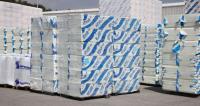 Add My Company
Add My Company
Sign In

The energy efficiency of a building often follows from the materials that create its envelope. And whether or not a project complies with today’s increasingly stringent energy standards greatly depends on the type of insulation used. PIR, PUR, XPS and EPS are popular insulation materials, each with their specific qualities. This article provides an overview of the differences between these products, enabling you to select the best type of insulation material for your project.
DIFFERENT MANUFACTURING PROCESSES
1. WHAT IS XPS?
XPS (extruded polystyrene insulation) is manufactured using extrusion: a continuous process which results in a closed-cell structure with a smooth skin on the top and bottom of the board. XPS’ closed-cell structure prevents water penetrating the structure of the insulation board and provides long term strength and durability.
2. WHAT IS EPS?
EPS (expanded polystyrene insulation) is manufactured using beads of foam within a mould. Heat or steam is applied directly to the beads, causing them to expand and fuse together. One cubic metre of EPS contains about 10 million beads, each counting approximately 3,000 cells which are closed off and filled with air. EPS is, in other words, composed of 2% polystyrene and 98% air. The manufacturing process results in a closed-cell structure, but not a closed-cell insulation board (due to voids that can occur between the beads).
3. PIR AND PUR
Like XPS, PIR and PUR are closed-cell insulation materials, but contrary to EPS and XPS, chemicals are the main ingredients of PIR and PUR. The latter insulation products consist of foam that is inserted between two liners or facings, such as a multilayer aluminium finish or mineral fleece. On the one hand, these facings ensure that the foam stays put. On the other, they trap the gas that is responsible for the excellent lambda value characterising the PU product family.
THE THERMAL CONDUCTIVITY OF EPS, XPS, PIR AND PUR
Insulation is one of the most practical and cost-effective ways to improve a building’s energy efficiency. By improving the insulation in new and existing buildings, significant cost savings and reductions in energy usage can be achieved.
Both XPS and EPS provide good thermal conductivity performance. However, the air trapped in the voids in the EPS will conduct heat. A much higher density EPS board will therefore be required to match the thermal performance of XPS insulation.
The lambda values of PIR and PUR are even better than that of XPS, allowing for very thin insulation layers. Yet when the facing that traps the foam (and the gas in the cells) is punctured or ripped, the lambda value declines.
COMPRESSIVE STRENGTH: XPS COMES OUT ON TOP
Excellent compressive strength is a must for insulation materials in the most challenging environments, such as under slabs on a flat roof, concrete floors, foundations, plaza and podium decks and cold storage. In general, when densities are compared, XPS has a greater compressive strength than EPS and PIR/PUR.
The compressive strength of EPS generally starts at around 70 kPa and extends to 250 kPa. Because of the way EPS is manufactured, it cannot match the higher compressive strengths of SOPRA XPS 500 and SOPRA XPS 700. The numbers in the latter two product names refer to CS(10\Y)500 and CS(10\Y)700: their respective compressive strengths at 10% deformation (kPa). For EPS and PIR/PUR to achieve the same compressive strength as XPS, then, the density of the foam would need to be increased, often resulting in a greater thickness of board.
WATER VAPOUR DIFFUSION RESISTANCE
EPS has a water vapour diffusion resistance of 30-70, whereas XPS reaches 80-250. Slightly more permeable to air and moisture, EPS is less resistant to water vapour than XPS. If you’re looking to insulate a space prone to humidity (e.g. floors, cellars, and foundation walls), XPS is your best option. PIR and PUR are a no-go in those scenarios, because water may soak into the compound of the product, increasing its weight and (in the longer term) reducing its thermal value.
APPLICATIONS: WHAT IS THE DIFFERENCE BETWEEN PIR AND XPS?
The best choice of insulation material depends on individual project circumstances.
XPS has many applications. It is …
… particularly suitable for inverted roofs, thanks to its closed-cell structure and extreme moisture-resistance.
… often used under slabs, concrete floors, foundations and underground works, due to its exceptional compressive strength.
PIR and PUR
… cannot be used in inverted roofs but are compatible with traditional warm roofs.
As a part of our service, Soprema remains at your disposal to help you select the appropriate insulation type for your project. We also consider hybrid insulation systems, which can be more cost-effective or offer advantages in terms of thermal value, design, and so on.
In addition, our insulation experts can help with your tapered roof design plans, zooming in on anything from gutters to outlets. The required slope can, for example, be achieved with a combination of EPS and PIR insulation products. Our designs are always done within the latest codes of practice, including the Building Regulations and BS 6229:2018.
THE SUSTAINABILITY QUESTION
For construction industry players who aim to build for the future, the environment is top of mind these days. PIR and PUR are chemical products that cannot be recycled, while EPS and XPS are more sustainable. EPS is made of only one material, and therefore easy to recycle. XPS, too, is 100% recyclable. Moreover, the latter insulation product is manufactured with – among other ingredients – end-of-life EPS and the cutting waste of other XPS boards, making it the choice par excellence for circular construction projects and proving that plastics in construction can indeed be sustainable.
Moreover, in our XPS factory in Tongeren (Belgium), the SOPRA XPS boards are manufactured with CO2 as a blowing agent instead of HFC or other chemical alternatives. This climate-friendly CO2 technology also contributes to the sustainable character of this insulation product.
SOPRA XPS INSULATION: REQUEST A SAMPLE
SOPRA XPS is an industry-leading range of extremely high performance, extruded polystyrene (XPS) closed-cell insulation boards which can be integrated into your roofing and waterproofing systems. Each board is suitable for many demanding and varied insulation applications such as inverted and green roofs including zero fall roof designs in conjunction with Soprema zero fall waterproofing systems, floors, walls and belowground works.
Interested in the flexibility, compatibility, and thermal efficiency that XPS offers for the entire building envelope? Request a sample here. Any questions about Soprema’s innovative insulation solutions? Don’t hesitate to contact us.
For more information on WHAT IS THE DIFFERENCE BETWEEN EPS AND XPS INSULATION? AND WHAT ABOUT PIR/PUR? talk to SOPREMA UK
Enquire Now
List your company on FindTheNeedle.
